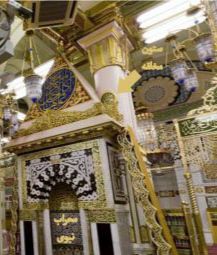Al-Mukhallaqa Pillar
 | |
| General Information | |
|---|---|
| Other Names | Al-'Alam Pillar |
| Place | Medina, al-Masjid al-Nabawi |
| Religious Aspect | |
| Rituals | Saying prayers next to this pillar is recommended |
| Current State | |
| Status | Al-Mukhallaqa Pillar is the closest pillar to the prophet's Mihrab , which is connected to the back of the mihrab from the west. |
Al-Mukhallaqa Pillar (Arabic: أُسطُوانَة المُخَلَّقَه) is one of the pillars of al-Masjid al-Nabawi and the closest pillar to the Prophet's Mihrab, which was the place of incense to perfume the al-Masjid al-Nabawi. After Qibla was changed in the second year of Hijra/624, the Prophet used to pray in front of this pillar for some time. Therefore, this pillar, which was the sign of the Prophet's prayer, was called the al-'Alam (sign) Pillar.
The sources mention that the al-Mukhallaqa Pillar is a blessed site and praying near it is fulfilled. It is also reported that Imam al-Rida(a) prayed 6 or 8 rak'ats next to this pillar.
Location
Al-Mukhallaqah Pillar is the closest pillar to the Prophet's Mihrab, and is now connected to the back of the mihrab from the west[1] and now it is a little ahead of its original place[2] and above it is written in a green circle with golden lines the words "أسطوانه المخلّقه" (al- Mukhallaqa Pillar).[3]
Name
The Arabic word, al-Mukhallaqa (المُخَلَّقه), is derived from khalūq (خَلوق) or khalāq (خَلاق) means a pleasant fragrance. It is a type of perfume whose major part is saffron.[4] This pillar was named al-Mukhallkha (perfumed) because to perfume the mosque, it was anointed with perfume or incense was burned on it.[5]
History
There are several narrations of the first people who tried to perfume the mosque:
- It is said that the first person who perfumed the Prophet's Mosque was the wife of 'Uthman b. Maz'un, one of the first Muslims, when her husband spat in the mosque, he washed and perfumed the mosque.[6]
- According to Jabir b. Abd Allah al-Ansari, the first person who perfumed the Prophet's Mosque was 'Uthman b. Affan.[7]
- During the Umayyah rule, 'Umar b. Abd al-'Aziz (R:99/717-8 -101/720) and during the Abbasid period[8], Khayzran, the mother of Harun al-Rashid, did so in 170/786-7.[9] It seems that since then, perfuming the mosque became pervalent.
Al-'Alam Pillar
After the Qibla was changed in the second year of Hijra/624, the Prophet Muhammad (s) stood for prayer in front of this pillar for some time. Then he prayed in the current mihrab, which is known as the Prophet's mihrab, and that pillar, which was closer to the mihrab than the other pillars, was placed behind the mihrab. It was also called "al-'Alam" (sign), meaning the sign of the Prophet's mihrab and Qibla.[10] Some historians of the Prophet's life consider this pillar to be the same as the Pillar of Repentance;[11] however, al-Waqidi, based on a narration, considers them to be two separate pillars.[12]
Virtue
One of the places where prayers are fulfilled is considered to be next to the al-Mukhallaqa Pillar.[13] According to a report, Salamat b. Akwa', a Companion and narrator of hadith of the Prophet (s), tried to perform his prayer near this pillar, and when they asked him the reason for it, he considered this to be the behavior of the Prophet.[14]
According to Shia narrations, Imam al-Rida (a) came to the Prophet's grave during his Umra and prayed six or eight rak'ats near the al-Mukhallaqa Pillar.[15] also the pillar is considered blessed.[16]
Notes
- ↑ Yamānī, Mawsūʿat Makka al-mukarrama, vol. 2, p. 435.
- ↑ Qāʾidān, Tārīkh wa āthār-i Islāmi-yi Makka wa Madīna, p. 191.
- ↑ Qāʾidān, Tārīkh wa āthār-i Islāmi-yi Makka wa Madīna, p. 191; Yamānī, Mawsūʿat Makka al-mukarrama, vol. 2, p. 435.
- ↑ Ibn Manẓūr, Lisān al-ʿArab, vol. 10, p. 91, word (خلق)
- ↑ Qāʾidān, Tārīkh wa āthār-i Islāmi-yi Makka wa Madīna, p. 191.
- ↑ Najjār,al-Durra al-thamīna, p. 100.
- ↑ Najjār,al-Durra al-thamīna, p. 100; Yamānī, Mawsūʿat Makka al-mukarrama, vol. 2, p. 436.
- ↑ Yamānī, Mawsūʿat Makka al-mukarrama, vol. 2, p. 436; Samhūdī, Wafāʾ al-wafā, vol. 1, p. 281.
- ↑ Samhūdī, Wafāʾ al-wafā, vol. 1, p. 350.
- ↑ Sayyid al-Wakīl, al-Masjid al-Nabawī ʿibar al-tārīkh, p. 50; Samhūdī, Wafāʾ al-wafā, vol. 2, p. 174.
- ↑ Ṣāliḥī al-Dimashqī, Subul al-hudā, vol. 5, p. 8; Ḥalabī, al-Sīra al-Ḥalabīyya, vol. 2, p. 664.
- ↑ Wāqidī, al-Maghāzī, vol. 2, p. 507.
- ↑ Ṣāliḥī al-Dimashqī, Subul al-hudā, vol. 3, p. 322.
- ↑ Ibn Ḥanbal, Musnad al-Imām Aḥmad, vol. 4, p. 48; Bukhārī, Ṣaḥīḥ al-Bukhārī, vol. 1, p. 127; Samhūdī, Wafāʾ al-wafā, vol. 2, p. 174.
- ↑ Ḥurr al-ʿĀmilī, Wasāʾil al-Shīʿa, vol. 5, 161; vol. 14, p. 359; Majlisī, Biḥār al-anwār, vol. 80, p. 314.
- ↑ Amīnī, Al-Ghadīr, vol. 5, p. 124.
References
- Bukhārī, Muḥammad b. Ismāʿīl al-. Ṣaḥīḥ al-Bukhārī. Beirut: Dār al-fikr, 1401 AH.
- Ḥalabī, Nūr al-Dīn al-. Al-Sīra al-Ḥalabīyya. Beirut: Dār al-Maʿrifa, 1400 AH.
- Ḥurr al-ʿĀmilī, Muḥammad b. al-Ḥasan al-. Wasāʾil al-Shīʿa. Qom: Muʾassasat Āl al-Bayt, 1414 AH.
- Ibn Ḥanbal, Aḥmad b. Muḥammad. Musnad al-Imām Aḥmad b. Ḥanbal. Beirut: Dār Ṣādir, [n.d].
- Ibn Manẓūr, Muḥammad b. Mukarram. Lisān al-ʿArab. Beirut: Dār al-Fikr, 1414 AH.
- Majlisī, Muḥammad Bāqir al-. Biḥār al-anwār. Second edition. Beirut: Dār Iḥyāʾ al-Turāth al-ʿArabī, 1403 AH.
- Najjār, Muḥammad b. Maḥmūd al-.Al-Durra al-thamīna fī akhbār al-madina. Medina: Markaz Buḥūth wa Dirāsāt al-Madina al-Munawwara, 1427 AH.
- Qāʾidān, Aṣghar. Tārīkh wa āthār-i Islāmi-yi Makka wa Madīna. 4th edition. Qom: Nashr-i Mashʿar, 1381 Sh.
- Ṣāliḥī Dimashqī, Muḥammad b. Yūsuf. Subul al-hudā wa al-rashād fī sīrat khayr al-ʿibād. 1st edition. Beirut: Dār al-Kutub al-ʿIlmīyya, 1414 AH.
- Sayyid al-Wakīl, Muḥammad al-.Al-masjid al-nabawī ʿibar al-tārīkh. [n.p], Dār al-Mujtamaʿ li-l-Nashr wa al-Tawziʿ, 1988.
- Wāqidī, Muḥammad b. ʿUmar al-. Al-Maghāzī. Edited by Marsden Jones. Beirut: Muʾassasa al-Aʿlām, 1409 AH.